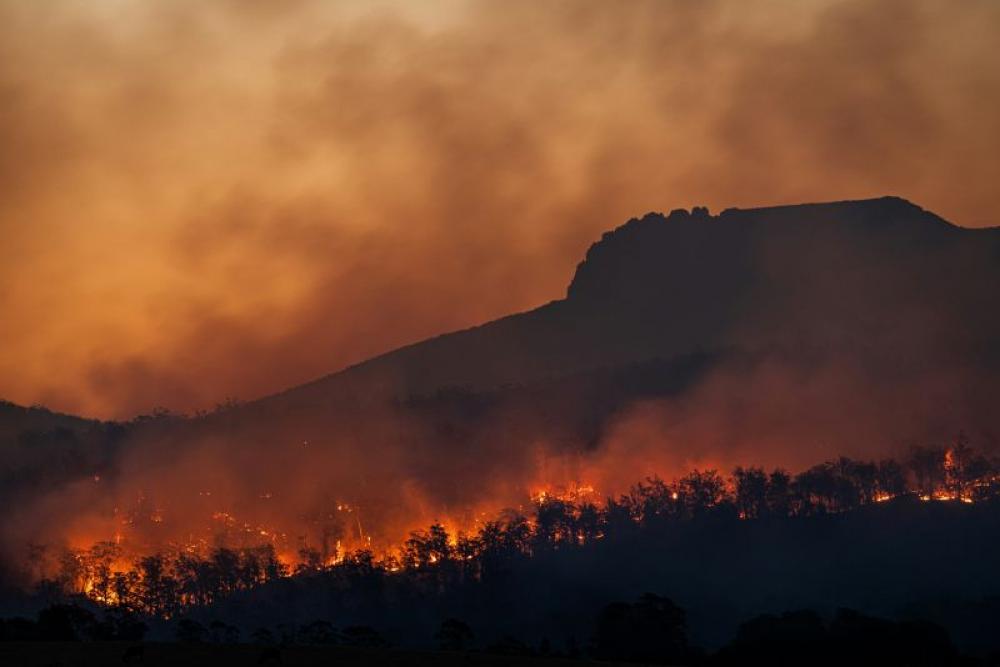Just Earth News | @justearthnews | 07 Aug 2025

Bushfires below Stacks Bluff, Tasmania, Australia. Photo: Unsplash
Extreme heat is breaking records around the world, with wildfires and poor air quality compounding the crisis, according to a report from the World Meteorological Organization (WMO) released Thursday.
Extreme temperatures caused approximately 489,000 heat-related deaths annually between 2000 and 2019, with 36 per cent occurring in Europe and 45 per cent in Asia.
The health impacts of heat are especially severe in cities due to the so-called ‘urban heat island effect’ – the over-heating of dense city areas compared with their rural surroundings – which is magnifying problems as urbanisation continues.
Amid rising 21st-century temperatures, the WMO underscored that July 2025 was the third-warmest July ever recorded, behind those in 2023 and 2024.
In this record-breaking July, heatwaves especially impacted Sweden and Finland, which experienced unusually long spells of temperatures above 30 degrees Celsius (86 degrees Fahrenheit).
Southeast Europe also faced heatwaves and wildfire activity, with Türkiye recording an extreme new national high of 50.5 degrees Celsius (122.9 degrees Fahrenheit).
In Asia, temperatures soared above average the most across the Himalayas, China and Japan in July, with extreme heat continuing into August.
In the week leading up to 5 August, temperatures surpassed 42 degrees Celsius (107 degrees Fahrenheit) across West Asia, southern Central Asia, the southwestern US, much of North Africa and southern Pakistan – with some areas exceeding 45 degrees Celsius (114 degrees Fahrenheit).
Parts of southwestern Iran and eastern Iraq saw particularly severe temperatures above 50 degrees Celsius (122 degrees Fahrenheit), disrupting electricity and water supplies, education and labor.
For the week of 4 August, Morocco issued heat warnings for temperatures up to 47 degrees Celsius (116 degrees Fahrenheit).
Korea also issued widespread heat warnings, as station temperature records were broken across parts of China.
In Japan, a new national temperature record of 41.8 degrees Celsius (107.2 degrees Fahrenheit) was set on 5 August, breaking the previous record of 41.2 degrees Celsius set a week prior.
Looking to next week, the World Meteorological Centre in Beijing forecasts that heatwaves will persist across the same regions as well as the Iberian Peninsula and northern Mexico.
These regions are expected to see maximum temperatures between 38 and 40 degrees Celsius (100.4 to 104 degrees Fahrenheit), with parts of Saudi Arabia, Iraq, Iran, North Africa and the southwestern U.S. likely to exceed 45 degrees Celsius (113 degrees Fahrenheit).
As Canada experiences one of its worst wildfire seasons on record, with 6.6 million hectares burned, smoke has polluted skies and caused poor air quality across several provinces and northern states of the US in late July and early August.
Twice this summer, smoke from Canadian fires crossed the Atlantic, affecting skies over Western Europe from 5–7 August and over Central and Southern Europe in late June.
Elsewhere, Cyprus, Greece and Türkiye have battled wildfires that forced evacuations and caused fatalities. In the US, a wildfire in Arizona’s Grand Canyon National Park disrupted tourism at the iconic site.
“Extreme heat is sometimes called the silent killer, but with today’s science, data and technologies, silence is no longer an excuse. Every single death from extreme heat is preventable,” said WMO Deputy Secretary-General Ko Barrett.
The WMO is working to strengthen heat early warning systems under the Early Warnings for All initiative. In collaboration with global and local partners, it is also helping countries develop heat-health action plans and ensure at-risk populations receive timely alerts.
WMO is also one of ten UN agencies supporting the Secretary-General’s Call to Action on Extreme Heat, which aims to boost global cooperation to reduce heat impacts through economic and social policy. A key focus is limiting global warming to 1.5 degrees Celsius above pre-industrial levels, in line with the 2015 Paris Agreement.
According to estimates from WMO and the World Health Organization (WHO), scaling up heat-health warning systems in 57 countries alone could save nearly 100,000 lives annually.
“Our Network is connecting science, policy, and action so that no community is left behind in the race to adapt to climate change that will continue to worsen extreme heat for years to come,” said Joy Shumake-Guillemot, lead of the WHO-WMO Climate and Health Joint Programme and co-lead of the Global Heat-Health Information Network (GHHIN).
“This is not just a climate issue, it’s a public health emergency,” she concluded.